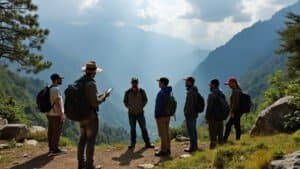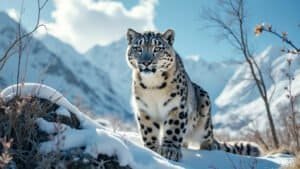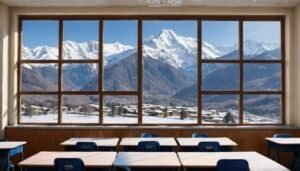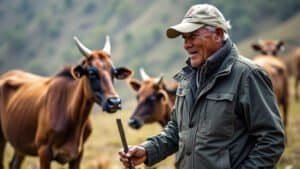Introduction
Documentaries have become powerful tools in raising awareness about the plight of snow leopards, an elusive and endangered species. These films not only capture the breathtaking beauty of snow leopards in their rugged habitats but also educate audiences on the critical issues threatening their survival
Throughout this article, we will explore the influence of documentaries on public perception, highlight notable films about snow leopards, examine the role of documentaries in conservation efforts, and discuss the challenges filmmakers face when documenting these majestic creatures in the wild
Additionally, we’ll delve into how these films educate viewers about the delicate ecosystems snow leopards inhabit
How Documentaries Influence Public Perception of Snow Leopards
Documentaries play a pivotal role in shaping public perception of snow leopards, especially since these elusive cats live in some of the most remote and inaccessible regions of the world
Many people will never encounter a snow leopard in the wild, making documentaries one of the few ways they can connect with and learn about this species
Through compelling storytelling, stunning visuals, and expert commentary, documentaries can turn a distant, unknown animal into a symbol of conservation efforts, thereby influencing how the public views and values snow leopards
Public Awareness and Snow Leopard Documentaries
The ability of documentaries to reach a broad audience is one of their greatest strengths. By showcasing the life of snow leopards, their behaviors, and the harsh conditions of their natural habitats, these films raise public awareness about the species’ existence and the challenges they face
For example, documentaries like “Ghost of the Mountains,” produced by Disney Nature, have brought the snow leopard’s plight into the homes of millions of viewers. The film follows a team of filmmakers as they endure the cold and treacherous terrain of the Tibetan Plateau to capture rare footage of snow leopards in the wild
Through the personal stories of the filmmakers and the incredible footage of the snow leopards, the documentary successfully raises awareness about the animal’s struggle for survival and the impact of human activities on their habitat
Shaping Conservation Narratives Through Film
Documentaries do more than just inform; they also inspire. By framing snow leopards within larger conservation narratives, these films can motivate viewers to care about the species and support conservation efforts
This is often achieved by highlighting the interconnectedness of ecosystems and the role that snow leopards play within them. For instance, the 2017 documentary “The Snow Leopard” emphasizes the importance of snow leopards as apex predators in maintaining the balance of their ecosystems
By illustrating how the decline of snow leopards could lead to overpopulation of prey species and subsequent degradation of vegetation, the film underscores the broader environmental consequences of losing these predators
Moreover, documentaries can influence policy and funding for conservation initiatives. When the public becomes more aware of the threats facing snow leopards, there is often a corresponding increase in demand for protective measures. Documentaries can thus serve as a catalyst for change by bringing these issues to the forefront of public discourse
This, in turn, can pressure governments, NGOs, and international organizations to take more decisive action in preserving snow leopard populations
Case Studies: Impactful Snow Leopard Documentaries
Several documentaries have made significant contributions to snow leopard conservation by altering public perception. For example, “Silent Roar: Searching for the Snow Leopard,” a BBC production, is credited with bringing global attention to the snow leopard’s endangered status
The film combines breathtaking cinematography with in-depth commentary from scientists and conservationists, providing viewers with a comprehensive understanding of the snow leopard’s behavior and the threats they face. The documentary’s wide reach helped increase public interest and concern for snow leopards, leading to greater support for conservation programs
Another influential documentary, “Vanishing Kings: Lions of the Namib,” though primarily focused on lions, includes a segment on the challenges faced by snow leopards due to similar environmental pressures
By drawing parallels between the conservation issues faced by different species in disparate regions, the film underscores the universal importance of wildlife protection, thereby broadening the scope of public concern to include snow leopards
Notable Documentaries About Snow Leopards
Documentaries about snow leopards have captivated audiences worldwide, offering a rare glimpse into the lives of these elusive cats. Through breathtaking cinematography and compelling narratives, these films not only entertain but also educate viewers about the conservation challenges facing snow leopards
In this section, we’ll explore some of the most notable documentaries that have made significant contributions to snow leopard awareness and conservation
Award-Winning Snow Leopard Documentaries
Several documentaries about snow leopards have received critical acclaim for their contribution to wildlife filmmaking and conservation. “Planet Earth II,” produced by the BBC, is one of the most celebrated nature documentaries, featuring a stunning segment on snow leopards
Narrated by Sir David Attenborough, the series showcases the dramatic and often harsh life of snow leopards in the Himalayas. The segment won praise for its unprecedented footage of snow leopards in the wild, offering viewers an intimate look at the animals’ behavior and challenges
Another award-winning documentary is “The Land of the Snow Leopard,” which received multiple accolades for its in-depth portrayal of the snow leopard’s habitat and the efforts of local communities to protect it
This film is particularly notable for highlighting the role of indigenous knowledge in snow leopard conservation, emphasizing how traditional practices can coexist with modern conservation strategies. By integrating cultural perspectives, the documentary provides a more holistic understanding of the efforts needed to protect these big cats
Behind the Scenes: Creating Snow Leopard Films
The making of snow leopard documentaries is often as captivating as the films themselves. Capturing footage of snow leopards in their natural habitat is a daunting task that requires patience, resilience, and cutting-edge technology
The documentary “Ghost of the Mountains,” produced by Disney Nature, offers viewers a behind-the-scenes look at the challenges filmmakers face when documenting these elusive creatures. The film crew spent several months in the remote regions of the Tibetan Plateau, enduring extreme weather conditions and treacherous terrain to capture rare footage of snow leopards
The documentary not only showcases the dedication of the filmmakers but also highlights the technical innovations that have made it possible to film snow leopards in the wild, such as the use of remote cameras and drones
Where to Watch Snow Leopard Documentaries
For those interested in learning more about snow leopards, several documentaries are available on popular streaming platforms. “The Snow Leopard,” a documentary by PBS Nature, is accessible on PBS’s streaming service and offers an in-depth look at the life of snow leopards in the Himalayas
The film covers the species’ behavior, habitat, and the conservation challenges they face, making it an excellent resource for viewers interested in snow leopard ecology
Similarly, “Planet Earth II” can be found on streaming platforms like Amazon Prime Video and Netflix, where viewers can watch the renowned segment on snow leopards as part of the series’ “Mountains” episode
Another documentary, “Silent Roar: Searching for the Snow Leopard,” is available through BBC’s iPlayer service, providing an engaging narrative about the efforts to study and protect snow leopards
The Role of Documentaries in Snow Leopard Conservation
Documentaries are more than just educational tools; they are powerful instruments for driving conservation efforts, particularly for species like snow leopards that are difficult to study and protect due to their elusive nature and remote habitats. By shining a spotlight on the challenges facing snow leopards, documentaries play a crucial role in mobilizing support for conservation initiatives
In this section, we’ll explore how documentaries contribute to snow leopard conservation through advocacy, research, and the promotion of conservation initiatives.
Documentaries as Tools for Conservation Advocacy
One of the most significant roles of documentaries is their ability to advocate for the conservation of snow leopards. By bringing the plight of these animals to a global audience, documentaries create a sense of urgency and a call to action
For example, the documentary “Vanishing Kings: Lions of the Namib,” while focused on lions, draws important parallels between the conservation challenges faced by different big cats, including snow leopards. This approach broadens the appeal of the film and helps viewers understand the interconnectedness of species conservation
Documentaries like “The Snow Leopard: Beyond the Myth” have also been instrumental in changing public perceptions. This film challenges the traditional view of snow leopards as solitary predators by revealing the social behaviors and complex lives of these animals. By humanizing snow leopards and showing their vulnerability, the documentary encourages viewers to empathize with the species and support conservation efforts
Additionally, the emotional impact of these films often translates into increased donations to conservation organizations and greater public support for protective legislation
How Films Contribute to Snow Leopard Research
Documentaries also contribute to scientific research on snow leopards by providing valuable data and increasing the visibility of ongoing studies
Filmmakers often collaborate with scientists and conservationists to document snow leopards in the wild, capturing rare behaviors and interactions that can be used for research purposes. For instance, the documentary “Ghost of the Mountains” features footage that has been used by researchers to study snow leopard behavior in remote areas of the Tibetan Plateau
Moreover, the exposure generated by documentaries can lead to new research opportunities. The popularity of snow leopard documentaries has resulted in increased funding for field studies, as more people become aware of the need to study and protect these animals
For example, the Snow Leopard Trust, an organization dedicated to snow leopard conservation, has benefited from the heightened awareness brought about by documentaries, leading to more extensive research and conservation programs in snow leopard habitats across Central Asia
Documentary-Inspired Conservation Initiatives
Many conservation initiatives have been directly inspired or supported by documentaries. By raising public awareness and fostering a connection between viewers and snow leopards, these films have helped launch and sustain various conservation projects
The Snow Leopard Conservancy, for example, has used documentary footage to highlight the importance of community-based conservation efforts. By showing how local communities can coexist with snow leopards, these documentaries have helped promote sustainable practices that benefit both the people and the animals
Additionally, documentaries have played a role in the creation of transboundary conservation areas, which are crucial for the survival of snow leopards whose habitats often span multiple countries
The documentary “The Snow Leopard and the Goat” highlights the success of such initiatives in regions like the Pamirs, where cooperation between nations is essential for the protection of snow leopard populations. These films have helped generate international support for the establishment of protected areas and the implementation of conservation policies
Challenges in Filming Snow Leopards in the Wild
Filming snow leopards is one of the most challenging tasks in wildlife documentary filmmaking. These elusive animals inhabit some of the most remote and rugged terrains on the planet, making it difficult for filmmakers to capture them on camera
The challenges go beyond just locating and filming the snow leopards; they also include ethical considerations, the harsh environmental conditions, and the technical difficulties of working in such extreme environments
In this section, we’ll explore the various challenges faced by filmmakers in their quest to document snow leopards in the wild
The Difficulties of Capturing Snow Leopards on Camera
Snow leopards are known for their elusive nature, often referred to as “ghosts of the mountains” due to their ability to blend seamlessly into their rocky, snowy surroundings
This camouflage, combined with their solitary and nocturnal habits, makes them incredibly difficult to spot, let alone film. Filmmakers often spend weeks, if not months, in the field without ever catching a glimpse of these elusive cats
The vast and rugged terrain of the snow leopard’s habitat poses another significant challenge. Snow leopards are found in the high mountain ranges of Central Asia, including the Himalayas, the Pamirs, and the Altai
These areas are characterized by steep cliffs, deep valleys, and extreme weather conditions, with temperatures often plunging below freezing. Filmmakers must endure these harsh conditions while carrying heavy equipment over treacherous terrain, often at altitudes where the air is thin, making the work physically demanding and exhausting
Additionally, the limited daylight hours and long, cold nights in snow leopard habitats further complicate the filming process. The filmmakers must be prepared to work under low light conditions and be patient, as snow leopards are most active during dawn and dusk
The unpredictable nature of wildlife also means that filmmakers must be ready to capture footage at a moment’s notice, which requires constant vigilance and readiness
Ethical Considerations in Wildlife Filmmaking
Filming snow leopards also raises important ethical considerations. The need to obtain close-up shots and detailed footage can sometimes lead to intrusive practices that disrupt the natural behavior of the animals
For example, the use of bait or other attractants to lure snow leopards into view is a controversial practice that can alter the animals’ natural hunting patterns and expose them to unnecessary risks
Filmmakers must also be mindful of the potential impact on local wildlife populations and ecosystems. The presence of a film crew in a remote area can disturb not only snow leopards but also other species that share their habitat
To minimize their impact, responsible filmmakers often work closely with conservationists and local communities to ensure that their activities do not harm the animals or their environment. They may also use remote cameras and drones to capture footage from a distance, reducing the need for direct human presence in sensitive areas
Another ethical challenge is the portrayal of snow leopards in documentaries. Filmmakers have a responsibility to present an accurate and balanced view of these animals, avoiding sensationalism or exaggeration. This includes being transparent about the challenges of filming snow leopards and the realities of their lives in the wild, rather than creating a narrative that prioritizes drama over factual accuracy
Overcoming Obstacles in Remote Snow Leopard Habitats
Despite the numerous challenges, advancements in technology have enabled filmmakers to overcome many of the obstacles associated with filming snow leopards. Remote camera traps, for instance, have revolutionized wildlife filmmaking by allowing filmmakers to capture candid footage of snow leopards without human presence
These cameras can be left in the field for extended periods, triggered by motion sensors to record the animals as they pass by. This method has yielded some of the most intimate and revealing footage of snow leopards ever captured
Drones have also become invaluable tools for wildlife filmmakers, providing aerial views of the vast landscapes that snow leopards inhabit. Drones can cover large areas quickly and access locations that would be impossible or dangerous for a human crew to reach
This technology has allowed filmmakers to track snow leopards over long distances and document their movements across the rugged terrain
In addition to technology, collaboration with local communities and conservation organizations is crucial for successful snow leopard filmmaking. Local knowledge of snow leopard behavior and habitats can greatly enhance the chances of locating and filming these animals
Moreover, involving local people in the filmmaking process can help build support for conservation efforts and ensure that the benefits of the documentary are shared with those who live in snow leopard habitats
Documentaries and Their Educational Impact on Snow Leopard Habitats
Documentaries serve as powerful educational tools, providing viewers with a deep understanding of the unique habitats that snow leopards call home. By showcasing the intricacies of these environments, documentaries help audiences appreciate the delicate balance required to sustain these ecosystems and the vital role snow leopards play within them
In this section, we will explore how documentaries educate viewers about snow leopard habitats, promote habitat preservation, and encourage sustainable practices
Educating Viewers About Snow Leopard Ecosystems
Snow leopards inhabit some of the most extreme environments on Earth, primarily the mountainous regions of Central Asia, including the Himalayas, the Tibetan Plateau, and the Altai Mountains
These areas are characterized by their high altitudes, harsh climates, and rugged terrain. Documentaries that focus on snow leopards often provide detailed insights into these ecosystems, explaining how the snow leopards have adapted to survive in such challenging conditions
For example, the documentary “The Snow Leopard: Beyond the Myth” offers an in-depth look at the snow leopard’s habitat, highlighting the diverse flora and fauna that share this environment
Viewers learn about the complex food web that supports snow leopards, from the prey species they hunt, such as blue sheep and ibex, to the vegetation that sustains these herbivores. By presenting the ecosystem as a whole, the documentary helps viewers understand how the survival of snow leopards is intricately linked to the health of their habitat
Additionally, documentaries often feature the work of scientists and conservationists who study these ecosystems. Through interviews and fieldwork footage, viewers gain insights into the methods used to monitor snow leopard populations and assess the health of their habitats
This scientific perspective enhances the educational value of documentaries, providing a comprehensive understanding of the environmental factors that affect snow leopard survival
Habitat Preservation Through Documentary Storytelling
Documentaries are particularly effective in raising awareness about the threats to snow leopard habitats. These threats include habitat fragmentation due to infrastructure development, climate change, and human-wildlife conflict. By bringing these issues to light, documentaries can galvanize public support for habitat preservation initiatives
One notable example is the documentary “Ghost of the Mountains,” which highlights the impact of climate change on the snow leopard’s habitat. The film explores how rising temperatures are leading to the retreat of glaciers and changes in vegetation patterns, which in turn affect the availability of prey for snow leopards
By visualizing these changes, the documentary makes the abstract concept of climate change more tangible for viewers, emphasizing the urgent need for action to protect these fragile ecosystems
Moreover, documentaries often showcase successful habitat preservation efforts, providing a hopeful narrative that encourages viewers to get involved
For instance, “The Snow Leopard and the Goat” features community-based conservation programs in the Pamirs, where local herders work alongside conservationists to protect snow leopard habitats. These stories demonstrate that habitat preservation is not only possible but also beneficial for both wildlife and local communities
Promoting Sustainable Practices via Documentaries
In addition to highlighting the importance of habitat preservation, documentaries can promote sustainable practices that help protect snow leopard habitats. Sustainable grazing practices, eco-tourism, and anti-poaching initiatives are just a few examples of the topics covered in snow leopard documentaries
For example, the documentary “Silent Roar: Searching for the Snow Leopard” discusses how sustainable grazing practices are being implemented in snow leopard habitats to reduce human-wildlife conflict
By managing livestock in ways that minimize competition with wild prey species, these practices help maintain the ecological balance needed for snow leopards to thrive. The documentary provides practical examples of how local communities can coexist with snow leopards, offering a blueprint for similar efforts in other regions
Eco-tourism is another sustainable practice often featured in documentaries. By showcasing the potential for responsible tourism to generate income for local communities while protecting snow leopard habitats, documentaries like “The Snow Leopard: Beyond the Myth” encourage viewers to support eco-tourism initiatives
These initiatives not only raise funds for conservation but also increase local awareness of the importance of preserving snow leopard habitats
Conclusion
Documentaries play an indispensable role in raising awareness about snow leopards and their conservation. Through breathtaking cinematography and compelling storytelling, these films bring the remote and often inaccessible world of snow leopards into the living rooms of global audiences
They influence public perception, foster empathy, and inspire collective action by highlighting the challenges snow leopards face, from habitat loss to climate change
By documenting the lives of snow leopards and the ecosystems they inhabit, documentaries educate viewers about the importance of preserving these majestic creatures and their habitats. They serve as powerful tools for conservation advocacy, providing a platform for researchers, conservationists, and local communities to share their stories and efforts in protecting this endangered species
Moreover, the challenges faced by filmmakers in capturing these elusive animals on camera underscore the importance of ethical and sustainable practices in wildlife filmmaking
As documentaries continue to reach wider audiences, their impact on snow leopard conservation becomes increasingly significant. These films not only entertain but also empower viewers to take action, whether through supporting conservation organizations, advocating for protective legislation, or adopting sustainable practices
Ultimately, documentaries help ensure that the story of the snow leopard continues to be told, inspiring future generations to appreciate and protect this incredible species








